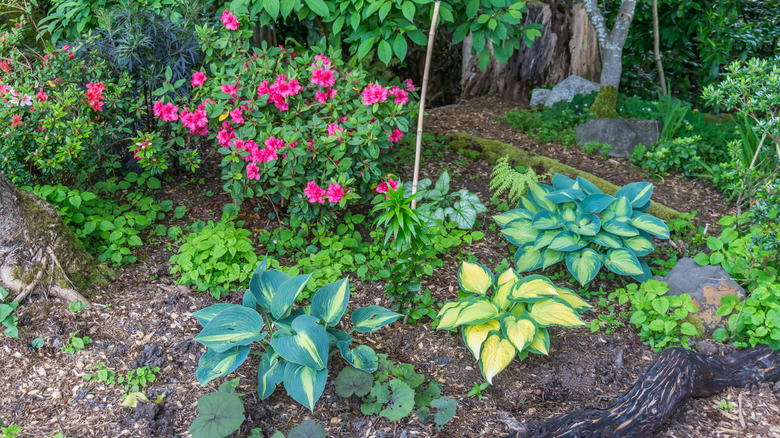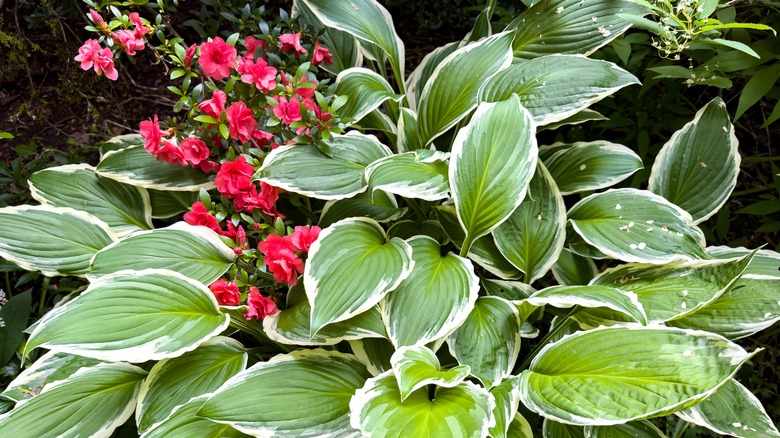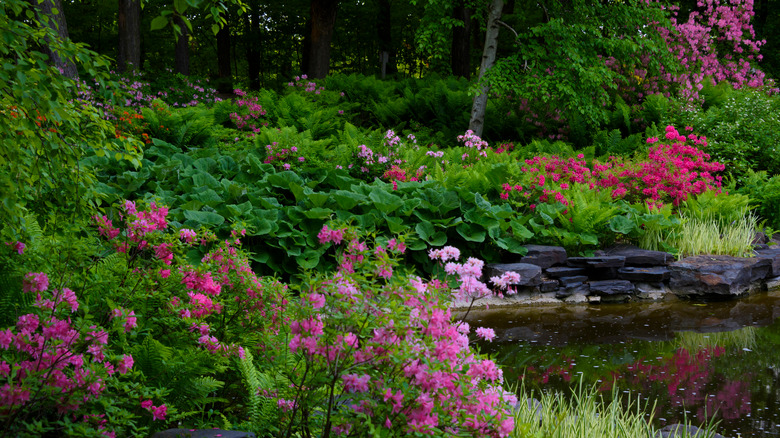Our Expert Gardener Unveils The Perfect Shade-Loving Perennial To Plant Alongside Your Stunning Azaleas
Azaleas are beautiful flowering shrubs that may be deciduous or evergreen. Their gorgeous blooms really light up the shade garden in the spring, with colors ranging from snowy white to deep magenta, with many shades of pink, coral, and orange. These reliable shrubs are easy to care for and prefer well-drained, slightly acidic soil. Given their love of the shade, azaleas pair very well with hostas as underplantings or companion plantings in the garden.
Though many azaleas bloom in early spring (March-April), some bloom a bit later and provide flowers in May and June. Some azaleas even rebloom in fall, bringing glorious color to the autumn shade garden. Hostas also form flowers on tall stems, blooming for about three weeks from late spring to late summer, depending on the variety. Many gardeners cut the flowering stems off to emphasize the leaves, but there are some hosta varieties with showy flowers that provide color in summer, between azalea bloom times in spring and fall.
If you have the space for a woodland garden, which combines trees and shade-loving plants, azaleas and hostas can be excellent foundation plantings for these semi-shade areas. Dappled sun/shade or partial sun also work just fine for azaleas and hostas. Most azaleas are hardy in USDA Zones 6-9, with some being cold hardy in Zone 5. Since most hostas are very cold hardy in Zones 3-9, they're very compatible with azaleas.
Planting hostas near azaleas
When planting some hostas near your azaleas, there are a few things to consider. Anyone who has grown hostas before knows they increase in size very reliably and need dividing every two to three years. It's important not to plant them too close to your azalea shrubs, to avoid their root systems becoming entangled; this would make it harder to divide hostas, and possibly damage the roots of your azalea.
Soil is important for both these shade-loving plants. To successfully care for your hostas and azaleas, both will need rich, well-drained, organic soil that is slightly acidic. Adding soil amendments such as compost, peat moss, coffee grounds, and pine needles is good for these plants. A natural shredded pine bark mulch around these plantings will break down naturally into the soil over time, providing good nutrients, as well as helping to protect roots, retain moisture, and prevent weeds.
Some hostas lose color with too much sun exposure, so be sure to plant them where they will be protected from direct afternoon sun. Dappled sun or morning sun are both fine for most hostas. You can choose to plant multiples of one variety of hosta for a classic, uniform look. If you decide to have a mix of small, medium, and larger-sized hostas, consider where to locate them for the best overall composition. Small or miniature hostas can work well as underplantings beneath your azaleas — just plant them at least 18 inches from the base of the shrub to give them room to co-exist.
Which hostas to choose
There are literally thousands of hosta varieties, and new hybrids and cultivars being introduced each year, as these sturdy shade perennials are a favorite obsession of plant breeders. Some hostas tolerate more sun than others, if that is a consideration for your space. Visual features to consider when choosing hostas to plant among your azaleas include size, shape, and color. Hostas have a vast size range, from 6-inch tall miniatures to giants that exceed 5 feet in height; depending on your space you may be able to plant a range of sizes.
Beautiful miniatures include Mouse Ears (blue-green), Mighty Mouse (dark green edged with yellow-green), Funny Mouse (green with creamy white edges), and Rainforest Sunrise (golden puckered leaves with green edges). Dramatic giant hostas include Big Daddy (blue-green puckered leaves), Kingsize (heart-shaped, deep-veined green leaves), and Sum and Substance (wide, yellow-green leaves). Try variegated medium-sized hostas to create contrast, like Fire and Ice (white with green edges), Francee (green with narrow white edges), or First Frost (blue-green with pale gold edges).
Also consider the bloom colors of your azaleas when choosing hostas to plant. Deep pinks and reds look great with yellow-green hostas like Orange Marmalade, Stained Glass, or Paul's Glory. Cooler colors like lavender, purple, and white flowers look terrific next to cool-toned blue hostas like Abiqua Drinking Gourd, Blue Angel, or Halcyon. Hostas also have a large array of leaf shapes (heart-shaped, slender, round, curling) and textures (shiny, puckered, deep-veined) to choose from.


